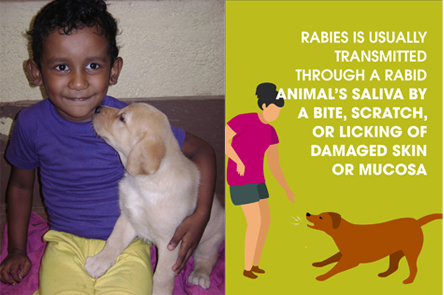Rabies Facts
What is Rabies?
Rabies is an invariably fatal but preventable zoonotic (transmitted from vertebrate animals to humans) viral disease of mammals. It is usually spread to people, pets, livestock and other mammals if they are bitten, scratched or licked by a rabid animal. In Sri Lanka and many other Asian countries, rabies is mostly found in dogs. However, cats and wild animals such as jackals, mongoose, polecats, civets and bats may also carry the disease. Most rabies deaths in people around the world and in our country are caused by rabid dog bites.The rabies virus infects the central nervous system. If a person does not receive the appropriate medical care (post-exposure prophylaxis and therapy) after a potential rabies exposure, the virus can cause infection in the brain, ultimately resulting in death within a few days. Rabies can be prevented by vaccinating to immunize pets against the disease, staying away from wildlife, and seeking medical care after potential exposures before signs and symptoms start.
What causes rabies?
Rabies is commonly caused by Rabies virus (RABV) which is a lyssavirus species. All lyssaviruses are pathogenic (able to cause disease) and can cause rabies in many species of mammals including humans. In addition to RABV, another lyssavirus species named as Gannoruwa Bat Lyssavirus (GBLV) is found in bats in our country.What are the animals that carry and transmit rabies (reservoirs and vectors of rabies)?
Rabies is mainly a disease of carnivorous mammals and bats. The causative viruses are maintained in two cycles namely, domestic/street and sylvatic (wild) cycles naturally. In our country, unimmunized domestic and stray dogs and cats maintain the domestic/street cycle while the wild carnivores such as jackals, mongooses, polecats, civets and bats contribute to the sylvatic cycle. All these animals infected with rabies are a potential source of the disease for people. The disease does not spread from man to man under natural conditions.How rabies is transmitted?
Rabies is transmitted to susceptible animals or humans by the introduction of the virus into cuts or wounds in the skin such as bite or scratch wounds, and via the intact mucous membranes in the eyes, nose and mouth. Bites, scratches or licking by infected mammals is the usual path of transmission to humans and animals. Transmission may also occur through abrasions, open wounds or mucous membranes that come into contact with saliva and other potentially infectious material e.g. brain tissue, cerebrospinal fluid (CSF) from rabid animals. The airborne spread has also been demonstrated in caves where myriads of bats were roosting. Other types of contact, such as petting a rabid animal or contact with the blood, urine or faeces of a rabid animal, are not associated with risk for infection and are not considered to be exposures of concern for rabies.Other uncommon modes of transmission:
Inhalation of aerosolized rabies virus is one potential non-bite route of exposure, but except for laboratory workers, most people won’t encounter an aerosol of rabies virus. Rabies transmission through corneal and solid organ transplants have been recorded, but they are also very rare.Bite and non-bite exposures from an infected person could theoretically transmit rabies, but no such cases have been documented. Casual contact, such as touching a person with rabies or contact with non-infectious material, fluid or tissue (urine, blood, faeces), is not associated with risk for infection. Contact with someone who is receiving rabies vaccination does not constitute rabies exposure, does not pose a risk for infection, and does not require post-exposure prophylaxis.
Rabies virus becomes noninfectious when it dries out and when it is exposed to sunlight or disinfectants. Different environmental conditions affect the rate at which the virus becomes inactive, but in general, if the material containing the virus is dry, the virus can be considered non-infectious.
How long the incubation period of rabies in animals?
The incubation period is the period between exposure to an infection and the appearance of the first clinical signs and/or symptoms. In rabies, the incubation period is unknown in most animal species. In dogs and cats, it is usually less than 6 months and commonly between 2 weeks to 3 months.How long the incubation period of rabies in people?
In humans, the incubation period varies from 5 days to several years depending on the number of viruses in the inoculum, density of the nerve endings at the wound site, and the distance between the virus entry and the central nervous system (brain and spinal cord). However, most people develop the disease in 2-3 months following exposure to the infection.How long the infectious Period of rabies?
The infectious period is the period during which an infected animal or person can transmit a pathogen to a susceptible host. Rabies virus may be shed for up to 10 days prior to the onset of clinical signs in animals and therefore, rabid animals can transmit the virus to other susceptible animals or people before and during the clinical course of the disease.How can we recognise rabid animals?
Clinical signs in carnivores including dogs and cats:Initial clinical signs of rabies are not different from many other diseases in animals. These initial signs include lethargy, fever, off food and water, difficulty in swallowing, vomiting, diarrhoea, excessive salivation, and frequent straining to urinate and/or defecate. There are two clinical forms namely, furious form and dumb form of rabies in carnivores such as dogs and cats.
Animals with furious rabies exhibit clinical signs of behavioural changes including increased aggressiveness and barking, fearfulness, restlessness, aimless wandering, biting anything encountered, and convulsions in the body.
Animals with dumb rabies display more dazed-like clinical signs such as partial or complete paralysis of different parts of the body including the tongue, and throat and respiratory muscles.
Animals with both furious and dumb forms of rabies die within a few days after the onset of clinical signs.
Clinical signs in herbivores:
Clinical signs of rabid herbivores include off food and water, frequent pressing of the head against hard objects such as walls or trees, etc., excessive salivation, frequent unusual vocalisation, frequent straining to urinate and/or defecate, unexplained hind-limb lameness and partial or complete paralysis of hind-limbs, coma and death.
Clinical signs in bats
Rabid bats may exhibit clinical signs such as off food, active during daylight hours, aggressive behaviour including biting anything encounter, abnormal eyeball movements, spontaneous vocalisation, coma and death.
All rabid animals irrespective of their species die shortly or usually within 3-8days after the onset of clinical signs. Some animals may be in a short period of unconscious state before death. Case Definition of Animal Rabies
How can we prevent rabies?
Prevention of rabies in PetsVisit your veterinarian with your pet on a regular basis and keep rabies vaccinations up-to-date for all dogs and cats. Maintain control of your pets by keeping them indoors and under direct supervision. Sterilise or neuter your pets to help reduce the number of unwanted pets that may not be properly cared for or vaccinated regularly. Take action to remove all stray animals from your neighborhood since these animals may be unvaccinated or sick.
Prevention of rabies in People
Know the risk: contact with rabid dogs is the leading cause of rabies deaths in our country, followed by exposure to infected cats and wild animals. Leave all wildlife alone. Wash animal bites or scratches immediately with soap and water. If you are bitten, scratched, or unsure, talk to a doctor or healthcare provider about whether you need post-exposure prophylaxis. Rabies in people is 100% preventable through prompt appropriate medical care.
If you had contact with an animal that may have rabies, like a bite from a dog or cat or contact with a bat or wild animal, see your doctor right away.
Regularly vaccinate to immunise your pets against rabies to protect them and your family from this dreaded disease.
Public Participation in Rabies Control








